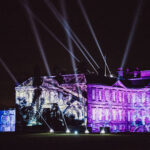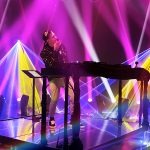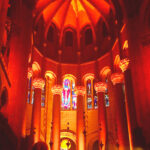Forever Cunard Marks 175 Years with a Queen Mary 2 Sound and Light Show in New York
An episode of the 1950s sitcom, The Honeymooners, might feature the greatest comedic line ever uttered in private, public or for broadcast media about an ocean liner.
When hopeless dreamer/NYC bus driver Ralph Kramden hatches another hare-brained moneymaking scheme, he turns to his ever-patient wife, Alice, and barks: “All your life you’re beefin’ and screaming, ‘When’s my ship gonna come in, when’s my ship gonna come in!’ Well, here it is. The Queen Mary!”
The Queen Mary has always symbolized the ultimate in everything. The very name speaks of majesty. The mother lode. Unparalleled refinement.
Today, the Queen Mary 2 (QM2), operated by the ship company Cunard, carries on its legacy. On the evening of July, 14, 2015, the QM2 was at the center of a spectacular lightshow in New York Harbor witnessed by PLSN from the very tip of Manhattan island, Battery Park. The lightshow marked the 175th anniversary of the Cunard’s first transatlantic crossing by its one-time flagship, the Britannia.
New York City area-based live event production and design firm Quantum Theatricals, tasked with producing the event, proposed the idea of the QM2 sailing into lower Manhattan. “New York has been our U.S. home port for decades, and has played a significant role in the transformative world events during our history,” says Richard Meadows, president of Cunard North America.
Dubbed Forever Cunard, the eight-minute sound and light show, according to Cunard’s own marketing material, was to be “cast over the ship, illuminating New York harbor and the sky above. It will bring viewers on a fantastic journey through Cunard’s 175 years of history, as well as celebrate the future that lies ahead.”
Cunard put so much stock in the lightshow and its preparation that they were willing to deviate, slightly, from the QM2’s strict sailing schedule to accommodate the celebration. “A big conversation in the beginning was that no one has ever really done anything like this before, at least not on this scale,” says Kelly Easterling, creative director and principal designer for Quantum Theatricals. “Cunard wanted to announce to the world that they are timeless.”
“Timeless and not rooted in the past,” adds Jayson Raitt, producer at Quantum Theatricals. “They recognize their place in history, but they are a modern cruise company. Doing a lightshow that’s brand-new, that hasn’t been done, is a great way to underscore that point.”
Deck 7
Quantum Theatricals asked themselves two major questions prior to work beginning in earnest on the event: “How do we host a light show on a cruise ship?” and “What location on the boat will offer onshore sightseers the best views?”
Given the size of the QM2 (approximately 1,132 feet in length and 131 feet wide), the possibilities seemed endless, like the rippling expanse of the Atlantic Ocean. Reality was another story.
“I think, creatively, we had originally wanted to decorate the ship with a bunch of moving lights on the bow and on the stern,” says Easterling. “But this was not feasible. As it happens, Deck 7 is the ship’s only exterior mid-level deck that allowed for us to install a good number of lights that we could place and space evenly in a line. There are balconies and private passenger areas that we can’t use, because nobody wants to have trussing and lighting equipment on their balcony.”
“The promenade deck on ocean liners, historically, have been the main focal point for watching the sea go by,” says Raitt. “We thought that in the historical context of Cunard, that would be a great place for the light show to emanate.”
The Setup
Prior to the Forever Cunard event, some of the members of the Quantum team flew to Canada and hopped onto the QM2 in Halifax, Nova Scotia, one of the ocean liner’s ports of call. (The ship’s journey originated in Southampton, England.) A few in Quantum’s crew, such as lighting designer Richard Chamblin and lighting operator/programmer Jackson Miller, remained aboard for six days.
After arriving in Nova Scotia on the morning of Friday, July 9, Chamblin and crew did all the necessary prepping. However, testing the equipment and conducting a full rehearsal could only be done at night, in international waters, and only with approval from the captain of the QM2.
“We were able to rehearse the show until sunrise, unless we were thwarted by rain, which happened only once,” adds Easterling.
Deck 7 was the logical choice for lighting to be set up, but the location of the units presented a few obstacles. For one thing, Quantum was made aware that under no circumstances were the beams from the lighting fixtures to interfere with the navigation of the ship.
“Because the lights are very bright, we had to make sure they never hit the bridge and become a distraction or obstruction for the crew,” says Richard Chamblin. “Then, of course, there were issues with the lifeboats and their proximity to the fixtures. When the lights were [placed in position] and pointed straight up, the fixtures were probably only about five or six feet away from the bottom of the lifeboats. Considering their power, the lights could burn a hole in the lifeboats.”
A tightly controlled show alleviated much of the spacing and safety issues. “Having focused palettes, about seventy-five to a hundred of them, helped to avoid all of that,” says Chamblin.
Ultimately, Deck 7 was outfitted with 50 Chauvet Legend 230SR Beam units (rented from Solotech), which were evenly spaced for uniform beam effects. Known for their brightness and precision, the Legends were placed on top of four-foot-by-12-inch box trussing.

“The uniformity and color temperature of the fixtures were, of course, essential for performing synchronized patterns and different types of effects,” says Easterling. They were chosen as the sole fixture emitting light from the boat itself.
The truss boxes, which were mounted on steel bases, secured the fixtures as the QM2 cut through the rough waters of the Atlantic. “Because we were at sea and the ship was moving, we had to strap the trussing to the steel handrail that runs along Deck 7 for that added little extra security,” says Chamblin.
Although Quantum Theatricals had been aboard the ship for walk-throughs prior to the July event, the creative team leaned heavily on MA Lighting’s MA 3D pre-visualization software. “Prior to rehearsals we hadn’t even seen our cues realized in real time from the ship,” says Easterling.
Under the guidance of Easterling and Raitt, Chamblin assisted in designing the lighting effects and synched them with the show’s accompanying soundscape. The programming “took a few weeks,” says Easterling, “with cues running the range of anywhere from 400 to 500 cues. The show was really my vision, but Chamblin is the one whose blood, sweat and tears is all over the console.”
GPS Magic
Rigging sound equipment added another complex layer to the show. From the beginning, the plan was for orchestral and film pieces, which make up the show’s soundtrack, to be pumped through a Meyer speaker array in Battery Park as the lighting effects of Forever Cunard dazzled onlookers.
To achieve total synchronization of sound and lighting, Quantum used an ETC Ion console onboard the QM2 and another on land, with a backup for each. Both consoles were running the same show files. Due to certain variables on the night of the show (i.e. FAA approval, QM2’s getting into position), Forever Cunard could not begin automatically at a predetermined time. (An enable button launches the show, prompting a time clock (with the assistance of contact closure circuitry) to trigger both ETC Ion consoles at the same nanosecond in time.)
“A custom GPS clock, the show clock, received ‘show time’ from a satellite, streaming time code,” says Easterling. “We have a sound file that’s running the show with SMPTE time code, living on an Alcorn McBride digital audio machine. Basically, the Alcorn McBride serves the Ion with time code and the Ion triggers the first cue. The Ion receives the trigger from the GPS clock and it sends a command to the digital audio machine to start time code. As soon as that digital audio machine starts up, the show runs on time code.”
Adds Easterling: “I personally designed and/or built the custom power connectors to take the feeds from the ship’s power as well as the custom GPS clock trigger devices. [The trigger devices] I had commissioned and then custom built by a studio equipment manufacturer.”
July 14, 2015
On the night of the event, a beautiful warm summer evening, PLSN passes through a crowd of thousands grooving to the sounds blasting off the Lowdown Hudson Music Festival stage. We want to stay to check out the lighting gear, but we know we must keep moving: it’s an audience with the Queen, further south in Battery Park, we seek.
Weaving our way around an array of steel barricades, not to mention oversized security guards, we escape the fray to find our semi-silent retreat near the southern tip of Manhattan. Suddenly, we catch a glimpse of the QM2 coming ‘round the bend. She drifts slowly westward and glides past a lit Lady Liberty, escorted by smaller sailing vessels.
Simultaneous with the light show, an outdoor V.I.P. event at the Battery Gardens is well underway. For the V.I.P. shindig, Easterling created a lighting design that incorporated a cache of Elation EPAR QA LED Pars controlled via DMX. “We didn’t use any wireless [DMX] on the ship for the show,” says Easterling. “That was all wired DMX. The wireless was used at Battery Gardens for the spectator event. It worked better than I had expected.”
Forever Cunard and the V.I.P. event in New York received “amazing” support from WorldStage, 4Wall Entertainment, Christie Lites and Solotech, says Easterling. “Our Canadian production manager, Shawn Fortis, coordinated with both Christie and Solotech to get the consoles, the fixtures, and the cable packages for the ship” for the Halifax load-in, with the other production companies providing the on-shore assist in New York.
At approximately 9:30 p.m., the bell in the Victorian tower of Pier A tolls. A minute or so later, a single beam of clear light emanates from the QM2’s Deck 7. The beam, we’ve been told, represents the 1840 launch of Cunard’s first ship, Britannia.
Synchronized shafts of clear, green, blue and yellow light crisscross and sweep before us, streaming up into the sky and hitting the murky water below. The fixtures’ movements are stunningly precise and their brightness, on occasion, blinding. With each sweep we hear “Oohs” and “Aahs” from bystanders.
For color washing and aerial effects, four Clay Paky Mythos units, controlled via City Theatrical’s SHoW DMX, were evenly spaced near the sea wall at the edge of Battery Park. “Because the Mythos were supposed to wash the boat with added color, we tried to be as precise as we could with their placement,” says Chamblin.
A visual, if somewhat abstract, narrative develops throughout the eight-minute show, taking us through Cunard’s pre-airline travel days to its role in transporting European immigrants, and then on toward the vacation-and-pleasure-cruise present.
Sometime after 9:40 p.m., three beams of light appear, representing Cunard’s three main vessels — the flagship Queen Mary 2, Queen Victoria and Queen Elizabeth. “Quantum is all about entertaining people, and not everyone has to read subtext into the light show,” says Raitt. “We always ask, ‘What experience do we want the audience to have, and what is driving our decisions?’”
A foghorn sounds a few times, signaling the conclusion of the presentation. And just like that, it’s over. We’re stunned. Speechless, actually, and we watch as the vessel virtually vanishes in the mists of dark sky and sea, heading for the vastness of the Atlantic. Our Forever Cunard experience has produced some unforeseen and mixed emotional responses. “Two ships…” as they say…
Later, as we trek through Battery Park City, we amble through the Lowdown Hudson Music Festival, again; rock act O.A.R. plays us out. The music is louder and more driving than anything we’ve heard all night, but somehow the volume doesn’t rattle us or dislodge our strange reverie.
Cunard’s plans to refurbish the QM2 in 2016 have us thinking. If the upgrade goes as scheduled, the ship PLSN recently spied will no longer exist in its current configuration, come summer next year. Suddenly, Quantum Theatricals’ lightshow gains even greater significance, helping to mark the closing chapter of an ever-spinning yarn, yet signaling a new beginning. We’re richer for this Battery Park experience and simply can’t shake the notion that we’ve just witnessed history.
Yes, Alice, it appears our ship has certainly come in.
Forever Cunard: July 14, 2015 – New York Harbor
Crew
Creative Director/Principal Designer: Kelly Easterling
Producer: Jayson Raitt
Lighting Designer: Richard Chamblin
Console Operator, QM2: Jackson Miller
Console Operator, Shoreside: Philip Vilar
Canada Production Manager: Shawn Fortis
Pre-Visualization: Earlybird Visual
Lighting/Audio Cos: Solotech, Christie Lites, WorldStage, 4Wall
Gear
50 Chauvet Legend 230SR Beams (onboard the QM2)
4 Clay Paky Mythos (shoreside)
2 ETC Ion consoles onboard QM2
2 ETC Ion consoles on shore
1 MA Lighting 3D software (for previz)
1 Box truss section (4’, 12”) for each ship-mounted fixture
Elation EPAR QA LED Pars (For Battery Gardens event)


